10 Space-Saving Vertical Garden Solutions for Urban Vegetable Growers
- Pocket Wall Planters – Transform your bare walls into productive growing spaces with fabric pocket planters. These flexible systems let you grow shallow-rooted vegetables like lettuce, spinach, and herbs in minimal space. Just attach them securely to any wall that receives adequate sunlight and enjoy your vertical salad bar.
- Pallet Gardens – Upcycle wooden pallets into vertical vegetable gardens by standing them upright against a wall. Line the back and sides with industry fabric, fill with soil, and plant through the slats. These sturdy structures work wonderfully for growing strawberries, herbs, lettuce, and trailing vegetables.
- Gutter Gardens – Mount vinyl gutters in rows on sunny walls or fences to create an efficient growing system for shallow-rooted vegetables. Drill drainage holes every 8 inches, attach securely to your structure, and fill with soil. Lettuce, radishes, arugula, and herbs thrive in these narrow but effective growing channels.
- Trellis Systems – Install trellis panels on balconies or against walls to support climbing vegetables. Cucumbers, peas, beans, and small squash varieties will happily grow upward instead of sprawling across your limited floor space. Use plant clips to guide their growth and prevent stem damage.
- Tower Gardens – Invest in vertical tower systems with multiple planting pockets arranged around a central core. These space-efficient answers can grow dozens of plants in a tiny footprint and often include self-watering features. Leafy greens, herbs, and strawberries excel in these systems.
- Hanging Basket Vegetables – Suspend hanging baskets from ceiling hooks, railings, or shepherd’s hooks to grow vegetables above ground level. Cherry tomatoes, bush beans, compact peppers, and herbs perform exceptionally well in hanging environments, providing both food and visual interest.
- Window Box Intensive Planting – Maximize your window ledges with deep window boxes planted using square-foot gardening principles. Divide each box into sections and grow different vegetables in each segment. Radishes, lettuce, compact herbs, and even dwarf carrots thrive in this arrangement.
- Shoe Organizer Gardens – Repurpose hanging shoe organizers into vertical herb and leafy green gardens. Fill each pocket with soil and plant individual herbs or lettuce varieties. Hang on any sunny wall or door and watch your compact garden flourish while taking up zero floor space.
- Tiered Plant Stands – Place multi-level plant stands in corners or against walls to grow vegetables at different heights. These systems effectively multiply your growing area by stacking plants vertically. Place sun-loving plants on top levels and shade-tolerant varieties on lower shelves.
- Bottle Tower Gardens – Create DIY vertical gardens using recycled plastic bottles connected in a tower formation. Cut openings in the sides for planting, connect bottles with sturdy rope or wire, and hang from a secure point. These self-watering systems work beautifully for herbs, strawberries, and leafy greens while incorporating sustainability into your garden design.
Transforming Balconies Into Productive Mini Farms: 5 Essential Strategies
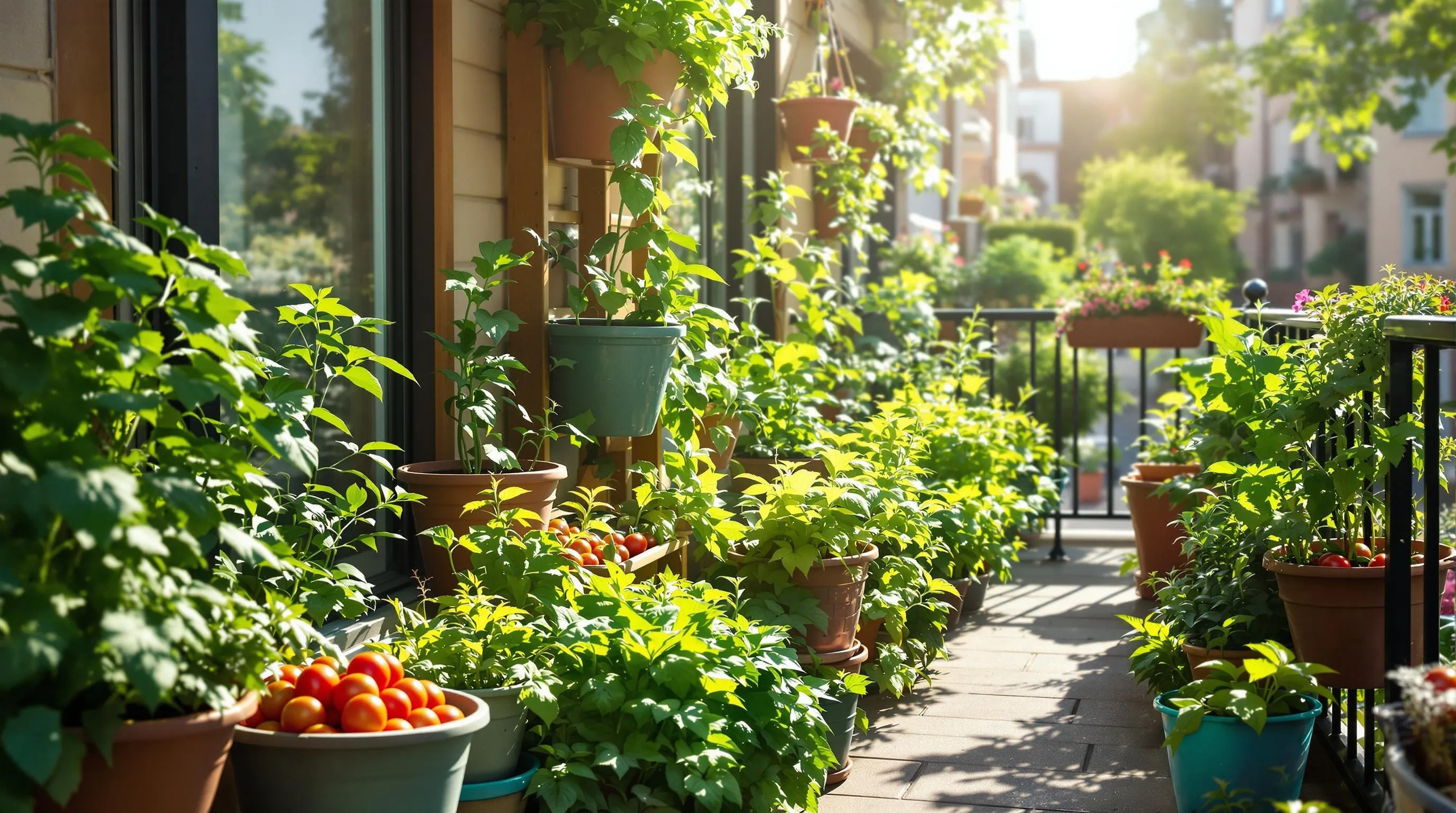
Even the smallest balcony can become a thriving vegetable garden with the right approach. Transform your urban balcony into a productive mini farm by implementing these five essential strategies that maximize your limited space.
Choosing the Right Containers for Balcony Vegetable Gardens
Container selection is crucial for balcony gardening success. Opt for lightweight yet durable materials like food-grade plastic or fabric grow bags that won’t overload your balcony’s weight capacity. Self-watering containers are ideal for busy gardeners, reducing maintenance while providing consistent moisture. For root vegetables like carrots and radishes, choose deep containers (at least 12 inches), while shallow vegetables like lettuce and herbs can thrive in 6-inch deep planters. Ensure all containers have adequate drainage holes to prevent waterlogging and root rot. Remember to consider the mature size of your plants when selecting containers—tomatoes and peppers need at least 5-gallon pots, while compact varieties like bush beans can grow in smaller vessels.
Maximizing Sunlight Exposure in Limited Spaces
Most vegetables require 6-8 hours of direct sunlight daily, making sunlight management essential for balcony gardens. Map your balcony’s sun patterns throughout the day using a sunlight tracking app to identify prime growing zones. Position taller plants like tomatoes and peppers on the north side of your balcony to prevent them from shading smaller plants. Use reflective surfaces such as aluminum foil or white-painted walls to bounce light onto shadier spots. For east or west-facing balconies with partial sun, focus on growing leafy greens, herbs, and root vegetables that can tolerate less direct light. Install adjustable shelving or hanging systems that allow you to reposition plants seasonally as the sun’s angle changes. In extremely hot climates, consider using shade cloth during peak summer hours to prevent leaf scorch while still allowing sufficient light penetration.
Implementing Space-Efficient Watering Systems
Install a drip irrigation system with a timer to ensure consistent watering without waste. These systems deliver water directly to plant roots, reducing evaporation and preventing water from dripping onto neighbors’ balconies below. Self-watering containers with built-in reservoirs can sustain plants for several days between refills—perfect for busy urban gardeners or hot weather conditions. Create a simple rainwater collection system using your balcony railing to capture natural precipitation in barrels or buckets. For tight spaces, use a compact watering can with a narrow spout that allows precise pouring without spilling. Group plants with similar water requirements together to streamline your irrigation schedule and prevent both overwatering and underwatering issues.
Creating Vertical Growing Opportunities
Vertical gardening dramatically increases your growing space by utilizing the height of your balcony rather than just the floor area. Install wall-mounted planters or pocket gardens on available vertical surfaces to grow compact vegetables and herbs without sacrificing floor space. Use railing planters that hang on the inside or outside of your balcony railing, creating an additional growing tier. Set up trellises or string systems against walls for climbing plants like cucumbers, peas, and pole beans, which can produce abundant harvests in minimal footprint. Stackable planters or tower gardens allow you to grow multiple plants in the same floor space footprint. Even your balcony ceiling can become productive by hanging plants like cherry tomatoes, strawberries, or trailing herbs in suspended baskets.
Selecting Compact and Dwarf Vegetable Varieties
Choose vegetable varieties specifically bred for container growing and small spaces. Look for descriptors like “bush,” “compact,” “dwarf,” or “patio” in seed catalogs and plant descriptions. Bush cucumber varieties like ‘Spacemaster’ produce full-sized fruits on non-vining plants that fit in 12-inch containers. ‘Patio Baby’ eggplants yield tender, egg-sized fruits on plants that grow just 18 inches tall. Cherry tomato varieties like ‘Tiny Tim’ or ‘Balcony’ were developed specifically for container growing, reaching only 12-18 inches in height while producing flavorful harvests. Miniature pepper varieties like ‘Redskin’ offer full pepper flavor on plants under 12 inches tall. Many seed companies now offer entire product lines dedicated to container and balcony gardening, making it easy to find varieties optimized for your limited growing space.
Rooftop Vegetable Gardens: Turning Unused Urban Spaces Into Food Havens
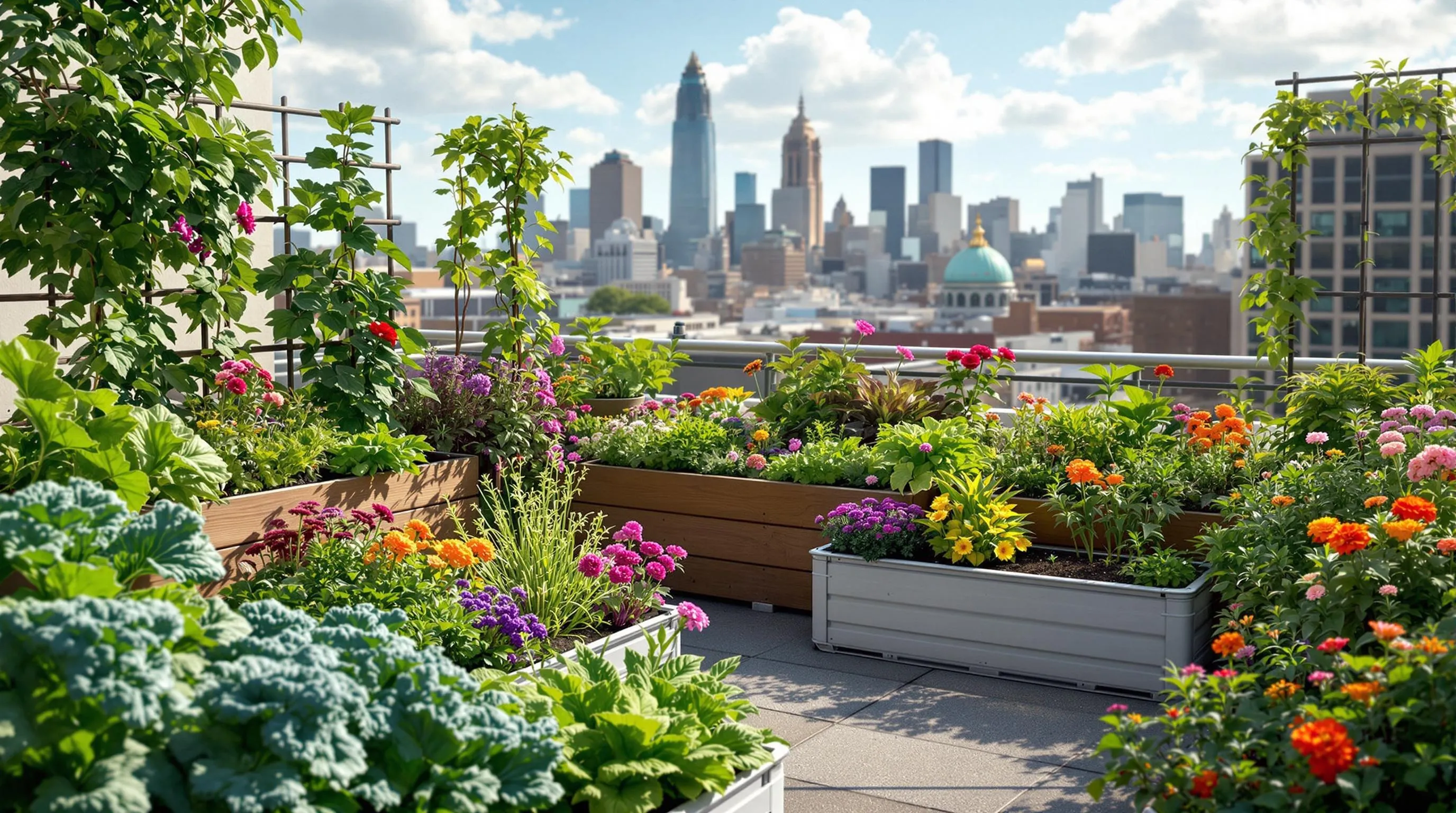
Rooftop gardens represent one of urban agriculture’s most exciting frontiers, transforming previously unused spaces into productive food sources. These elevated growing areas not only provide fresh produce but also help reduce urban heat islands and improve air quality while utilizing space that would otherwise remain dormant.
Lightweight Growing Medium Options for Rooftop Safety
When creating a rooftop garden, choosing the right growing medium is crucial for structural safety. Standard garden soil is far too heavy and can damage your building’s integrity. Instead, opt for lightweight soilless mixes specifically formulated for rooftop applications. Commercial rooftop blends typically contain expanded shale, perlite, vermiculite, and coconut coir—materials that retain moisture while minimizing weight. Consider ASTM-certified green roof substrates that weigh 30-40% less than traditional soil when saturated. You can also create your own mix using equal parts compost, perlite, and peat moss or coir. These lightweight alternatives provide proper drainage and aeration while keeping your building’s structural engineers happy.
Weather-Resistant Crops for Exposed Rooftop Conditions
Rooftop environments present unique challenges including stronger winds, more intense sun exposure, and rapid temperature fluctuations. Select hardy vegetable varieties that can withstand these conditions. Tough leafy greens like kale, Swiss chard, and collards thrive in rooftop settings and can withstand temperature variations. Root vegetables such as radishes, beets, and carrots perform exceptionally well, protected from the elements while their tops provide stability against wind. Mediterranean herbs including rosemary, thyme, and sage are naturally adapted to harsh, sunny conditions and actually prefer the well-drained environment of rooftop containers. For fruiting crops, try determinate tomato varieties, peppers, and bush beans, which can be grown in deeper containers with proper support systems to prevent wind damage. Install windbreaks using bamboo screens or decorative trellises to protect more delicate crops while adding aesthetic appeal to your rooftop oasis.
Community Garden Participation: Joining Forces for Urban Food Production
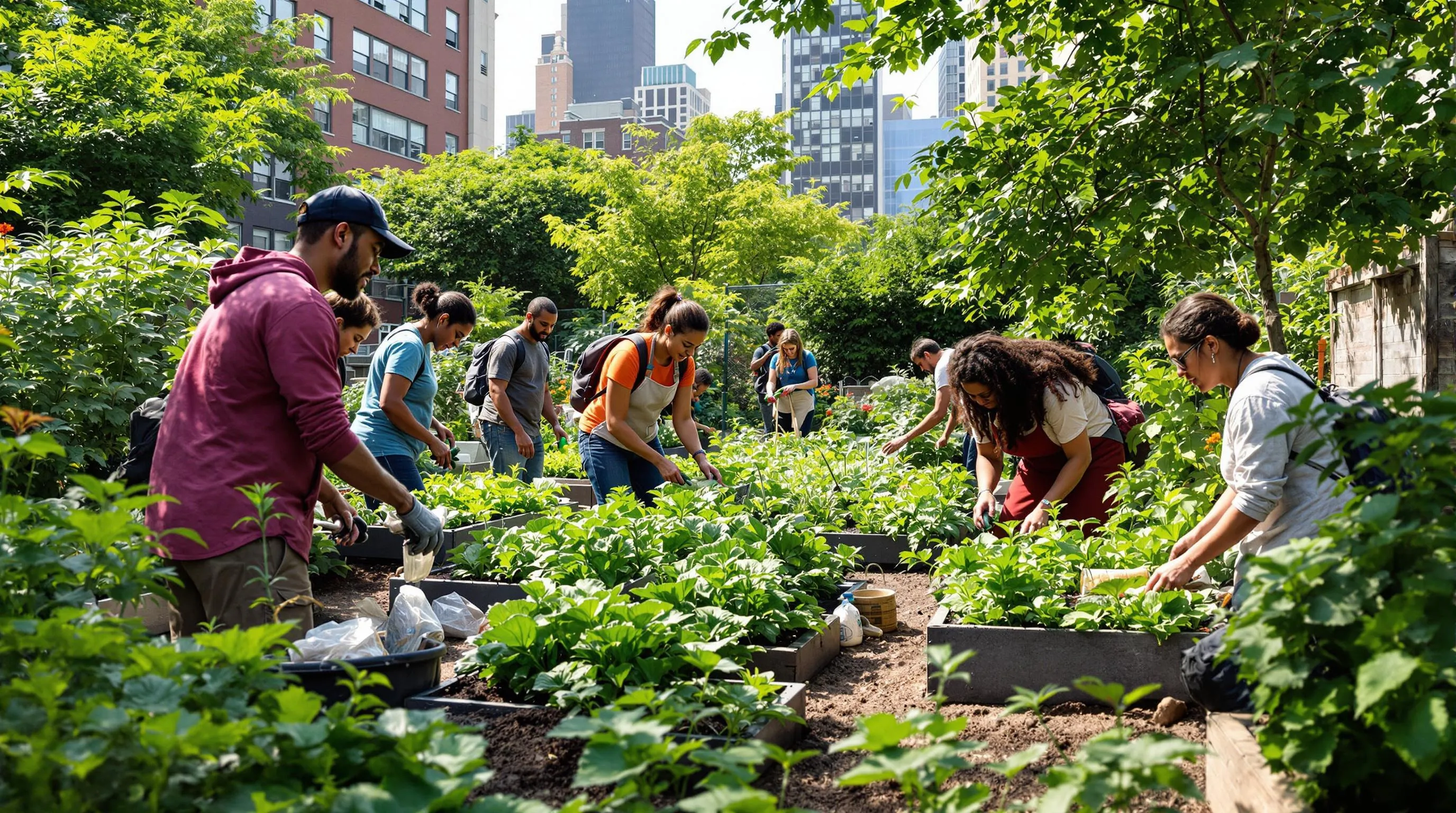
Community gardens offer a powerful solution for urban dwellers lacking personal growing space. These shared plots transform vacant lots into productive growing areas while fostering neighborhood connections. To get involved, start by researching local community gardens through online directories like the American Community Gardening Association or your city’s parks department. Visit potential gardens during open hours to assess plot availability, membership fees, and community dynamics. Most gardens require members to sign agreements outlining responsibilities like regular maintenance and shared workdays. You’ll typically pay seasonal dues ($20-100 annually) for water access and shared tools. The benefits extend beyond fresh produce—you’ll gain gardening knowledge from experienced neighbors, share harvests, and participate in community events like seed swaps and harvest festivals. Many urban community gardens also partner with local food banks, allowing you to contribute to food security initiatives while growing your own vegetables.
Hydroponic Systems: Soil-Free Solutions for Indoor Urban Vegetable Growing
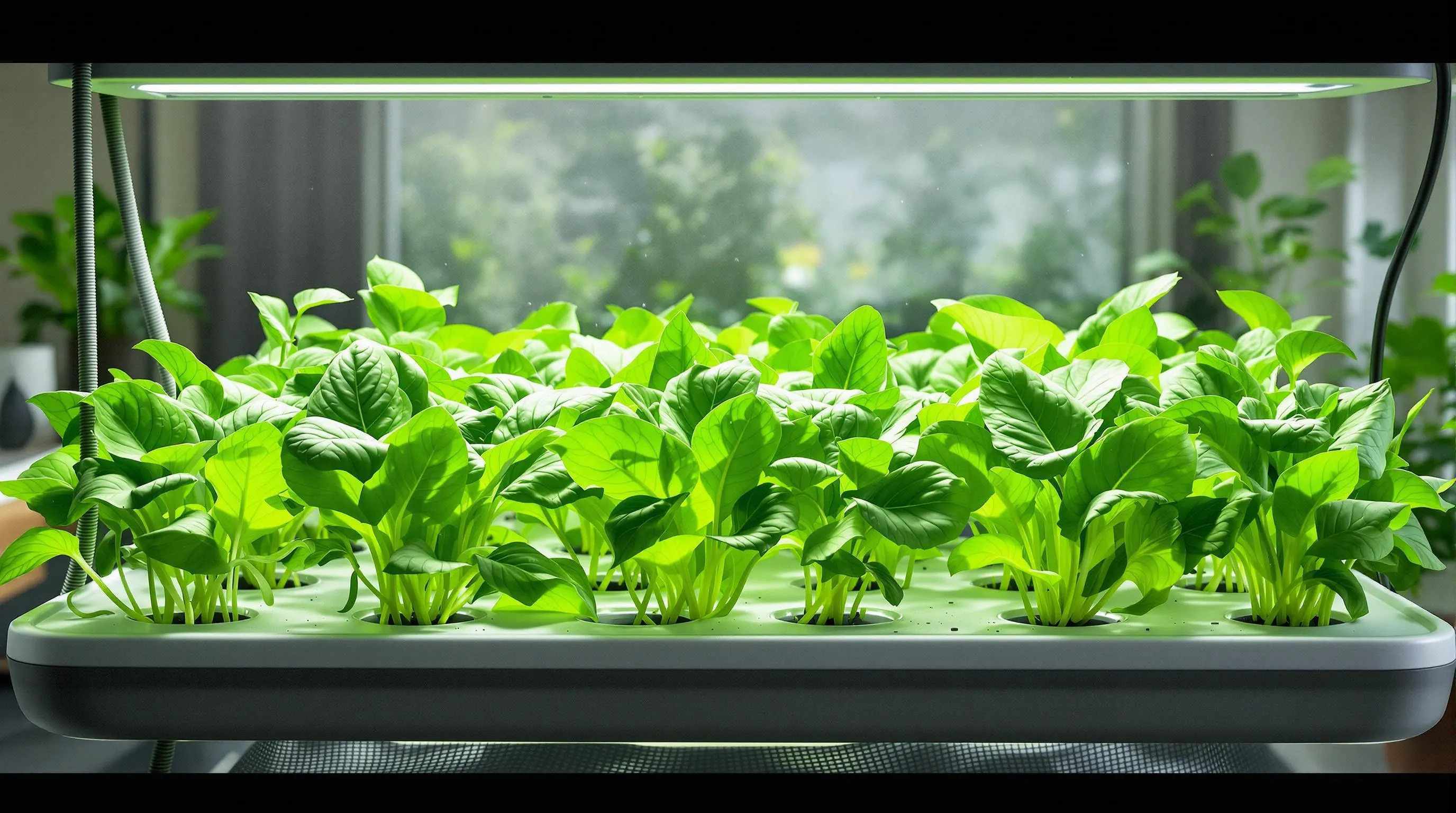
Hydroponic systems offer a revolutionary approach to urban gardening by eliminating soil entirely. These water-based growing methods deliver nutrients directly to plant roots, resulting in faster growth and higher yields in minimal space. You can easily set up a simple deep water culture system by suspending plants in nutrient-rich water using net pots and air stones, perfect for leafy greens like lettuce and spinach. For a more space-efficient option, vertical hydroponic towers allow you to grow dozens of plants in a single square foot of floor space. Nutrient film technique (NFT) systems use shallow channels where a thin film of nutrient solution flows over plant roots, ideal for herbs and compact vegetables. Wick systems offer the simplest, low-maintenance option, using passive wicking material to draw nutrients up to plants with no electricity required. For tech-savvy gardeners, smart hydroponic kits with automated nutrient delivery and grow light systems can turn any indoor space into a productive vegetable garden year-round, regardless of outdoor conditions or limited natural light.
Window Sill Herb and Microgreen Gardens for Tiny Urban Kitchens
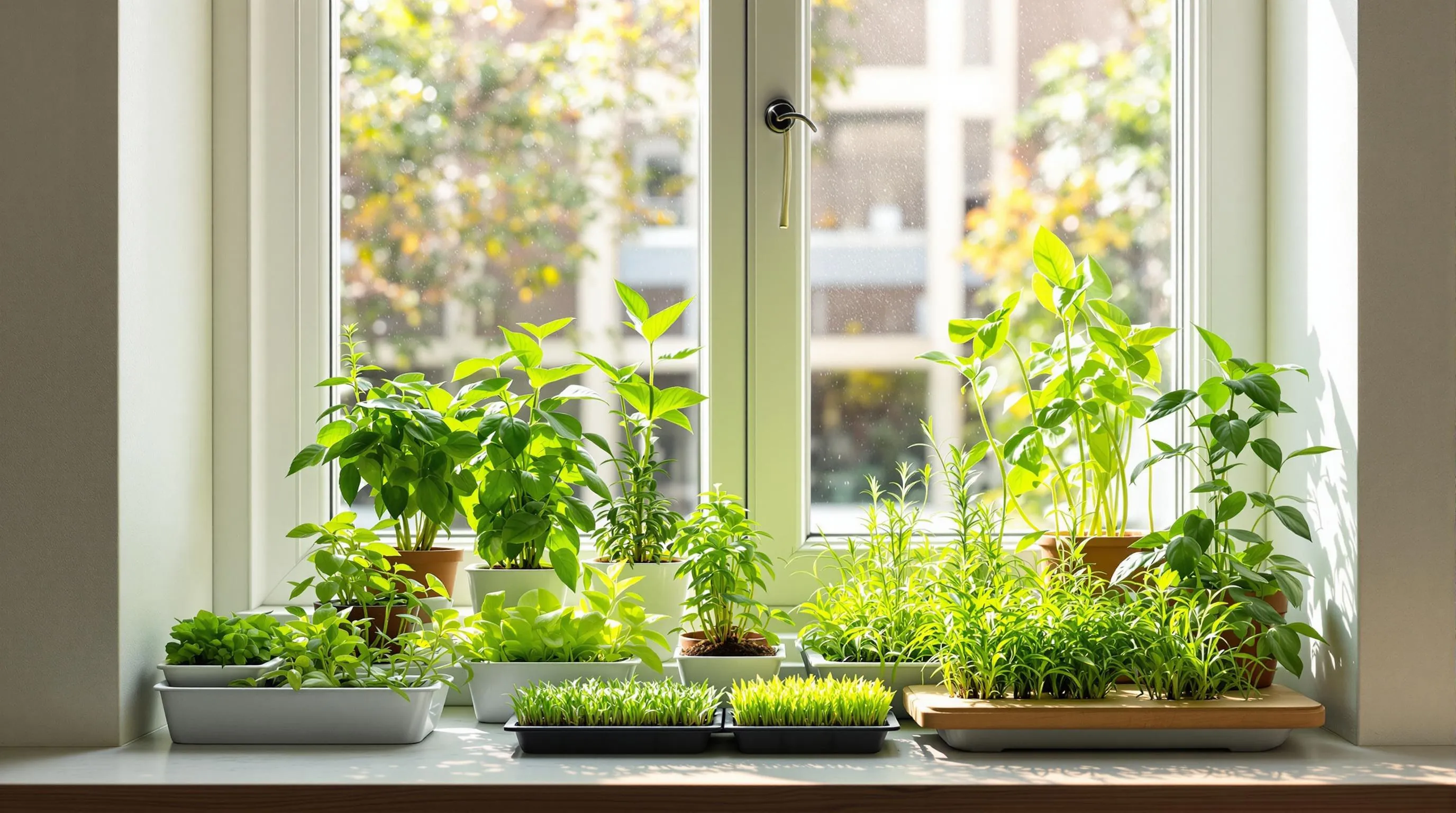
Even in the smallest urban apartments, your kitchen window sill offers prime real estate for growing fresh herbs and nutrient-dense microgreens. These compact gardens require minimal space while delivering maximum flavor and nutrition to your meals. Start by selecting shallow containers with drainage holes that fit your window sill dimensions. For herbs, choose varieties that thrive indoors like basil, chives, mint, and rosemary—all perfect for snipping fresh as needed for cooking. Position sun-loving herbs like basil and rosemary in south-facing windows, while mint and parsley can tolerate less direct light. For microgreens, use seed-starting trays filled with 1-2 inches of potting mix, densely sow seeds like kale, radish, or sunflower, and harvest within 7-14 days when they reach 2-3 inches tall. The quick growth cycle means you’ll enjoy fresh harvests year-round, regardless of outdoor growing conditions. Rotate your containers regularly to ensure even growth, and use a small watering can with a narrow spout to prevent overwatering these delicate plants. Your window sill garden not only provides fresh flavors for your meals but also brings living greenery into your kitchen space, creating a mini oasis in your urban dwelling.
Container Combinations: Companion Planting in Urban Garden Pots
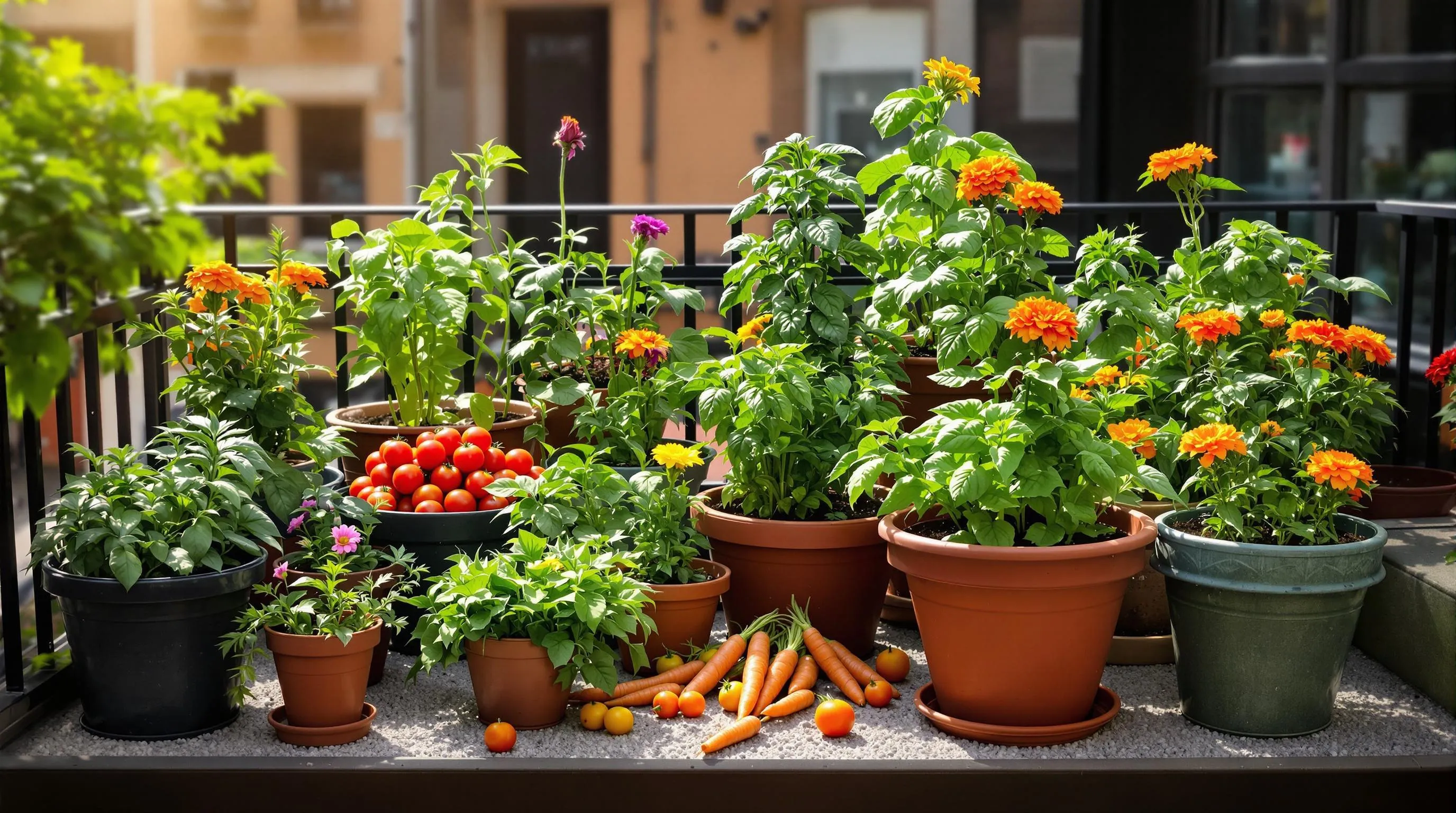
Maximize your urban container garden’s potential by implementing companion planting strategies. This age-old gardening technique pairs plants that mutually benefit each other, creating stronger, more productive mini-ecosystems even in limited spaces.
Space-Efficient Vegetable Pairings
Strategic plant combinations can dramatically increase your container garden’s yield while saving precious urban space. Try the “Three Sisters” method in a larger pot by planting corn as a central support, pole beans to climb the corn and fix nitrogen, and squash below to shade the soil and reduce weeds. For shallow containers, pair fast-growing radishes with slow-developing carrots—the radishes will be harvested before carrots need the space. Combine basil with tomatoes in 5-gallon buckets; basil improves tomato flavor while repelling flies and mosquitoes. Lettuce and spinach work well as shallow-rooted companions for deeper-rooted peppers, maximizing vertical growing space. For herb containers, mix chives, parsley, and thyme which share similar water requirements while offering complementary flavors. These thoughtful pairings ensure every inch of your limited urban growing space produces maximum results.
Pest-Deterrent Plant Combinations
Transform your container garden into a natural pest management system with strategic companion planting. Marigolds deter aphids, nematodes, and whiteflies when planted alongside tomatoes or cucumbers in pots. Interplant garlic or chives with carrots to repel carrot flies while maximizing container space. Nasturtiums serve as sacrificial “trap crops” for aphids, protecting your nearby vegetables while adding edible flowers to your harvest. Place containers of fragrant herbs like rosemary, mint, or lavender between vegetable pots to confuse and deter cabbage moths and other flying pests. For tomato containers, add basil which repels tomato hornworms and improves flavor simultaneously. These protective pairings reduce the need for pesticides while creating resilient, productive mini-ecosystems in your urban container garden, proving that even the smallest spaces can benefit from companion planting principles.
Innovative Repurposed Materials for Budget-Friendly Urban Gardens
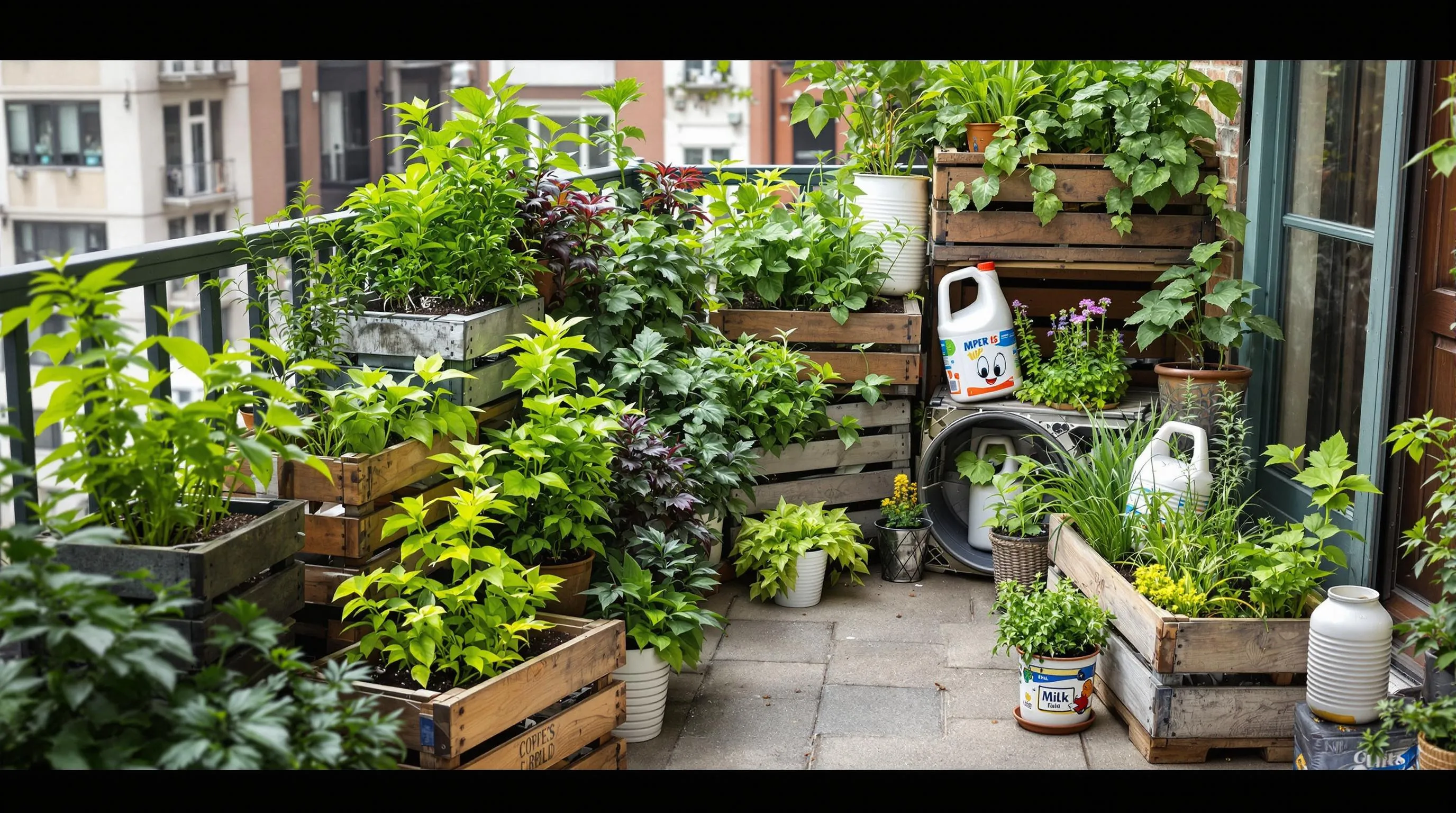
Urban gardening doesn’t have to expensive when you repurpose everyday items as growing containers. Old wooden crates make excellent raised beds for root vegetables and leafy greens, adding rustic charm while providing proper drainage. Coffee cans, once cleaned and punctured with drainage holes, transform into perfect herb planters that can be mounted on kitchen walls or arranged on windowsills. Plastic milk jugs cut horizontally create mini-greenhouses for seedlings, while their bottom sections serve as water reservoirs for self-watering containers. Broken dresser drawers become instant garden beds when lined with industry fabric and filled with soil. Even worn-out rain gutters can be mounted on fences or balcony railings to grow shallow-rooted crops like lettuce, radishes, and herbs. These budget-friendly alternatives not only reduce waste but also add personality to your urban garden while providing the same growing benefits as expensive commercial planters.
High-Yield Vegetable Varieties Specifically Bred for Urban Conditions
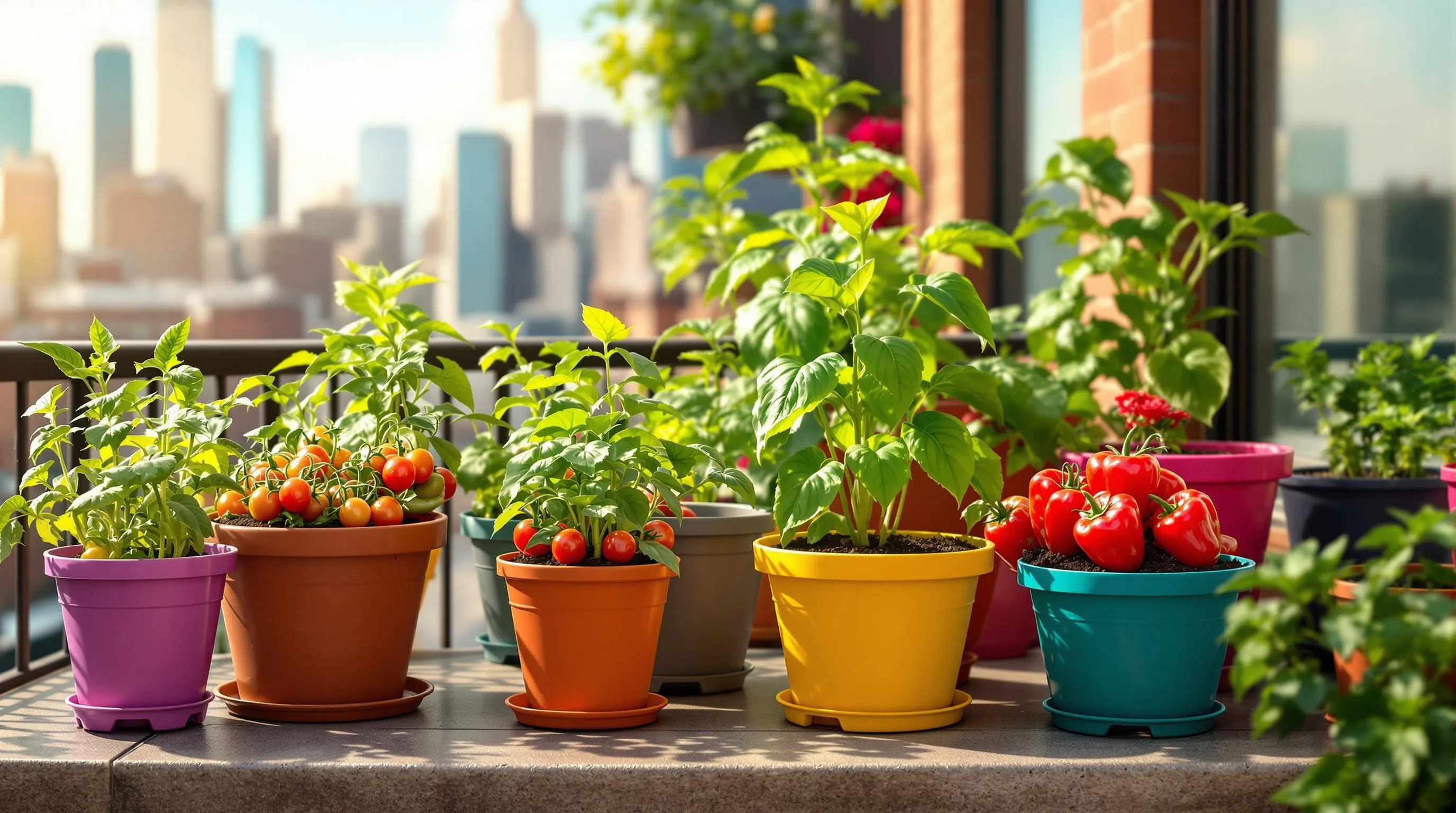
Urban gardening success depends largely on selecting the right vegetable varieties. Plant breeders have developed compact, productive cultivars specifically designed for containers, balconies, and small spaces. These urban-friendly varieties offer impressive yields without requiring extensive growing space. Determinate or “bush” tomatoes like ‘Tiny Tim’ and ‘Patio Princess’ produce full-sized fruits on plants reaching only 12-24 inches tall. ‘Fairy Tale’ eggplants yield tender, sweet fruits on compact 18-inch plants, perfect for containers. For leafy greens, ‘Baby Leaf’ lettuce varieties provide multiple harvests from minimal space. ‘Bush Champion’ cucumbers offer full-sized fruits on vines requiring minimal staking. ‘Patio Pride’ peas mature quickly and grow just 8-10 inches tall. ‘Emerite’ pole beans produce heavily on vertical supports, while ‘Mascotte’ bush beans yield tender pods in containers. Heat-tolerant ‘Patio Star’ zucchini produces abundantly on compact plants. ‘Mini Bell’ peppers offer colorful, sweet fruits on space-saving plants. These specialized varieties let you maximize harvests even in the smallest urban growing spaces, bringing the joy of homegrown vegetables to city dwellers with limited gardening area.
Seasonal Planning for Year-Round Urban Vegetable Harvests
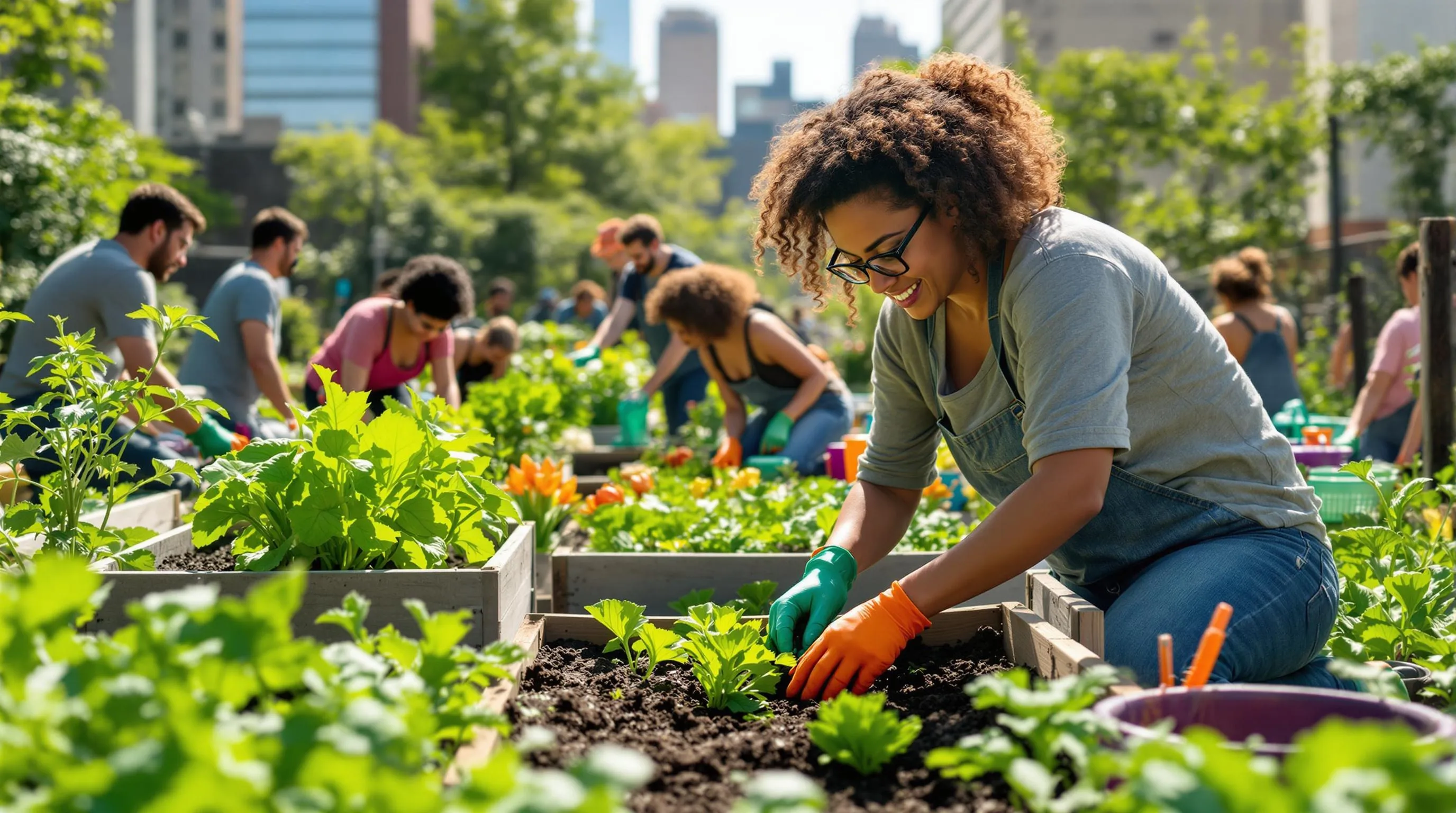
Maximizing your urban vegetable garden requires strategic seasonal planning to ensure continuous harvests throughout the year. Start by creating a customized planting calendar based on your local climate zone, noting first and last frost dates to optimize growing windows. Carry out succession planting by sowing quick-growing crops like radishes and lettuce every 2-3 weeks during their growing season. Extend your growing seasons with simple protection methods such as cold frames, row covers, or mini hoop tunnels that can add 4-6 weeks to both ends of your growing calendar. For winter harvests, focus on cold-hardy vegetables like kale, Brussels sprouts, and carrots that can withstand frost and even improve in flavor after light freezes. During summer’s peak, transition to heat-loving crops such as peppers, eggplants, and tomatoes while preparing seedlings for fall planting. Incorporate perennial vegetables like asparagus, rhubarb, and artichokes that return year after year, providing reliable harvests with minimal effort. By developing this cyclical approach to planting, you’ll transform your urban garden from a seasonal hobby into a perpetual food production system that delivers fresh vegetables in every season.
Overcoming Urban Garden Challenges: Solutions for Shade, Pollution and Limited Space
Urban vegetable gardening isn’t just a hobby—it’s a revolutionary way to reconnect with your food in concrete jungles. Whether you’re transforming a tiny windowsill rooftop or joining a community plot you’ve now discovered multiple pathways to growing fresh produce regardless of your living situation.
The beauty of urban gardening lies in its adaptability. From hydroponic systems and vertical answers to companion planting and repurposed containers your options are virtually limitless. Even the smallest spaces can yield impressive harvests with the right approach.
By implementing these creative gardening strategies you’re not just growing food—you’re cultivating sustainability building community and reclaiming your connection to nature. Your urban vegetable garden awaits regardless of how limited your space may seem. The first seed you plant is the beginning of your urban farming journey.







